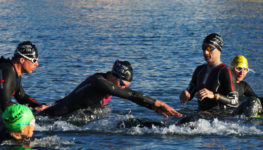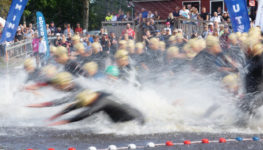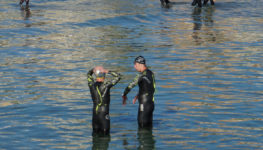Triathlon Swim Training – Boost enjoyment
Triathlon swim training, like all training, should be enjoyable (to keep you doing it and looking forward to doing it). It should also be specific to your race objectives – in distance and environment.
This means training should replicate race demands through covering, in total, the distance involved and practicing in the environments planned to race in (pools, lakes, seas, rivers, etc).
Here we focus on the enjoyment side and how to make sessions easier, as well as specific, rather than on the swim sessions themselves.
 Pool based swimming and triathlon swimming are very different (for obvious reasons). Triathlon swim training should therefore be approached differently. This makes training more enjoyable. Focus should be placed on the arms and much less on traditional swim driven drills and skills.
Pool based swimming and triathlon swimming are very different (for obvious reasons). Triathlon swim training should therefore be approached differently. This makes training more enjoyable. Focus should be placed on the arms and much less on traditional swim driven drills and skills.
What to include for triathlon swim training enjoyment
Buoyancy Tools
Buoyancy tools – pull buoys, shorts, etc – help place the body in a better position (horizontal) and allows the swimmer to focus on the important part of swimming – the arm stroke. Swimming will become more enjoyable as strength and fitness improves (proven in races even when not using buoyancy tools). For many, as large a pull buoy as possible is best – men especially. Alternative to pull buoys, and preferably, as they are more “natural”, use a pair of buoyancy shorts. Not all buoyancy shorts are equal, as we’ll see, but a well fitted and higher density pair will make you feel so much better.
Buoyancy Shorts
Buoyancy shorts offer a better solution to a pull buoy as they are very specific and non-intrusive; ie you wear them like any swim kit. They also provide the correct feel – and are much closer at replicating the feel of a wearing a wetsuit.
Buoyancy shorts come in various thicknesses. To really reap the benefits, you need a pair that provide a good level of floatation. The more your legs naturally sink, the thicker the buoyance shorts needed.
We would recommend a thicker pair for most, the pair of Zoots in the above picture are ideal, and possibly in a size smaller than you would normally select, to stop them filling up when pushing off. As when buying a wetsuit, try testing a pair before committing to them.
Why train with additional buoyancy
 Places you in a horizontal position, offering less resistance; which will
Places you in a horizontal position, offering less resistance; which will- allow your arms to perform the stroke better and so be more effective, while
- reducing shoulder impingement issues related to pulling with sinking legs
Just like having strong streamlined push off, people see pull buoys and buoyancy shorts as a cheat. But think about it – if it makes you feel better, you are more relaxed, reduce strain and injury rate and you perform better – where is the cheating?
Your aim for triathlon swim training is to become stronger and improve your ability to push water back, to sustain this for your intended race distance and to be injury free!
What NOT to include to increase enjoyment (and triathlon ability)
Two big factors we recommend removing from your swim training for triathlon:

- Swim drills – unless absolutely necessary, such as for a complete beginner to learn a movement / position, they waste time. For ADULT, non-competitive swimmers, just swimming is the way to go – as long as coaching cues are given for stroke corrections and for efficiency gains.
- Kicking drills – often prescribed as being essential. Only if your kick is adding drag, through excessive bending, should you perform simple kick sets. You’re a triathlete and you will already know that kicking is:
- hard work and exhausting
- often not very effective
- as a triathlete you need to save energy and your legs for what is to come!
Basically, just let your legs find their own rhythm but don’t use them – there is often an “involuntary” movement that follows your arm action; just let that happen.
Conclusion
To enjoy your triathlon swim training, focus on developing strength in your upper body by using buoyancy shorts or pull buoys. Build movement patterns and muscular endurance by swimming!
Remember, triathlon swimming is different to competitive swim training – the environments and conditions are NOT the same and your body is NOT like that of an elite pool swimmer. Don’t confuse or try to overlap the training approaches; endless drills and kicking will become frustrating (if they haven’t already!) and yield limited benefits…



